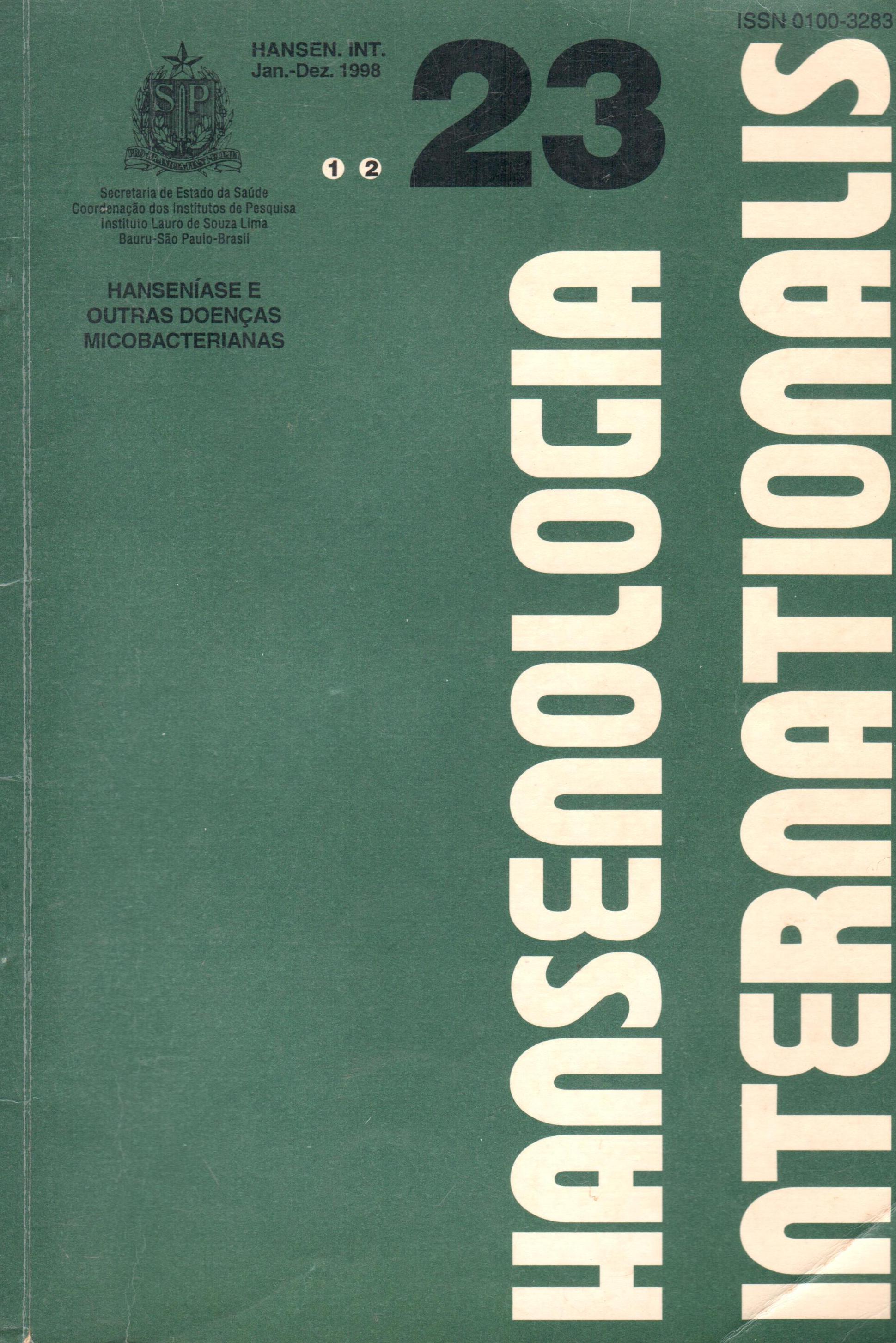Abstract
Skin tests are utilized in the follow up of leprosy patients, constituting one of the parameters for the classification of the clinical forms of this disease, its prognosis and even for treatment indication and follow up. These tests have been developed in the first quarter of this century and are based on bacilli suspensions obtained from human lesions or from infected armadillos. In this paper, we review the characteristics of lepromin or Mitsuda antigen and other alternative tests. The potential of recombinant antigens in the preparation of skin tests is also highlighted as a future perspective for the preparation of improved, standardized and more specific reagents, in comparison from those tests obtained from human lesions or armadillos.
References
2. FERNANDEZ, J.M.M. The early reaction induced by lepromin. Int. J. Leprosy, v.8, p.1-14, 1940.
3. GILL, H.K. , MUSTAFA, A.S., GODAL, T. Vaccination of human volunteers with heat - killed M. leprae: local responses in relation to the interpretation of the lepromin reaction. Int. J. Leprosy, v. 56. p.36-44, 1988.
4. GUPTE, M.D., VALLISHAYEE, R.S., ANATHARAMAN, D.S. et al. Effect of skin test with M. leprae soluble antigen on reaction to a subsequent test with the same antigen. Int. J. Leprosy, v.60, p.54-60, 1992.
5. HASTINGS, R.C., GILLIS, T.P., KRAHENBUHL, J.L. et al. Leprosy. Clin. Microbial. Rev., v.1, p.330- 348, 1988.
6. HAYASHI, Y. On a pure culture of leprosy bacilli and skin reactions by means of the pure culture syspensions. Saikin-qaku Zasshi J. Bacteriol., v.272, p.51-53, 1918. Republicado em Int. J. Leprosy, v.21, p.370-372, 1953.
7. KOOIJ, R., GERRITSEN, T. Positive 'lepromin' reactions with suspensions of normal tissue particles. Int. J. Leprosy, v.24, p.71-181, 1956.
8. KOOIJ, R. The natur of the Mitsuda reaction. Leprosy Rev., v.30, p.137-139, 1959.
9. KUMAR, B., KAUR, S., SHARMA, V.K. et al. Lepromin-H versus lepromin-A. Ind. J. Leprosy, v.56, p.50-57, 1984.
10. LARA, C.B., NOLASCO, J.O. Self - healing, or abortive, and residual forms of childhood leprosy and their probable significance. Int. J. Leprosy, v. 24, p.245-263, 1956.
11. LEIKER, D.L. Studies on the lepromin test: I. influence of tha bacillary and tissue components in dilutions of lepromin. Int. J. Leprosy, v.29, p.157-167, 1961.
12. MEHRA, V.L., SALGAME, P., SNAPPER, S.B. et al. Vaccines against leprosy. In: PLATKIN, S.A., MORTIMER JR., E. A. eds. Vaccines. Philadelphia: WB Saunders, 1988.
13. MEYERS, W.M., KVERNES, S., BINFORD, C.H. Compar ison of react ions to human and armadillo lepromins in leprosy. Int. J. Leprosy, v.43, p.128-225, 1975.
14. MITSUDA, K. On the value of a skin reaction to a suspension of leprous nodules. Hifuka Hinyôka Zasshi. Japanese Journal of Dermatology and
Urology, v,19, p.697-708, 1919. Republicado e traduzido em: Int. I. Leprosy, v.21, p.347-358, 1953.
15. NEWELL, K.W. An epidemiologist's view of leprosy. Bull. WHO, v.34, p.827-857, 1966.
16.PESSOLANI, M.C.V., HUNTER, S.W., BRENNAN, R. Relat ionship between host histones and armadillo. derived Mycobacterium leprae. Int. J. Leprosy, v. 61, p.381-388, 1993.
17. PINTO, M.R.M., ERIYAGAMA, N.B., PEMAJAYANTHA, V. Immunological effects of lepromin testing in sri Lankan population groups. II. Effect on reactivity to a soluble protein antigen of Mycobacterium leprae. Leprosy Rev v.58, p.227-232, 1987.
18. PONNINGHAUS, J.M., FINE, P.E.M. Sensitization studies with potential leprosyvaccine preparations in Northern Malawi. Int. J. Leprosy, v.54, p.25-37, 1986.
19. REES, R.J.W. Progress in the preparation of an antileprosy vaccine from armadillo-derived Mycobacterium leprae. Int. I. Leprosy, v.51, p.515-518, 1983.
20. RIDLEY, D.S., JOPLING, W.B. Classification of leprosy according to immunity. A five group system. Int. J. Leprosy, v.34, p.255-273, 1966.
21. SENGUPTA, U. Studies on lepromin and soluble antigens of M. leprae: their classification, standardization and use. Indian. J. Leprosy, v.63. p.457-463, 1991.
22. SHEPARD, C.C., DRAPER, P., REES, R.J.W. et al. Effect of purification steps on the immunogenicity of Mycobacterium leprae. Br.J. Exp. Pathol., v.61, p. 376-379, 1980.
2 3 . SHEPARD, C.C., MINAGAWA, F., VAN LANDIGHAM, R.V. et al. Foot pad enlargement a s a me a s u r e o f i n d u c e d immu n i t y t o
Mycobacterium leprae. Int. J. Leprosy, v.48, p.371-381, 1980.
24. SHIELD, M.J., STANFORD, J.L., GARBAJOSA, G. et al. The epidemiological evaluation, in burma, of the skin test reagent LRA6; a cell free extract from armadillo derived Mycobacterium leprae. Part 1: leprosy patients. Int. J. Leprosy, v. 50, p.436-445, 1982.
25. SHIELD, M.J., STANFORD, J . L . The epidemiological evaluation, in burma, of the skin test reagent LRA6: a cell free extract from armadillo derived Mycobacterium leprae. Part 2: close contacts and non-contacts of bacilliferous leprosy patients. Int. J. Leprosy, v.50, p.446-454, 1982.
26. WADE, H.W. Induction of lepromin reactivity by repeated lepromin testing. Int. J. Leprosy, v.23, p. 310-315, 1955.
2 7 . WORLD HEALTH ORGANIZATION. Recommended safety requirements for the preparation of lepromin: a WHO memorandum. Bull. WHO, v.57, p.921-923, 1979.
28. WORLD HEALTH ORGANIZATION. Leprosy. In: __________ Tropical Diseases Research: Progress 1991 - 1992. Eleventh Programme Report of the UNDP/ World Bank/ WHO special Programme for Research and Training in Tropical Diseases (TDR). Geneva: 1993. p.47-55.

This work is licensed under a Creative Commons Attribution 4.0 International License.
